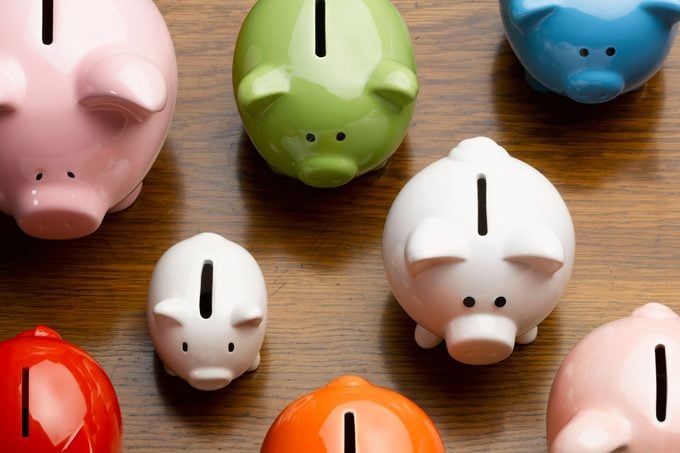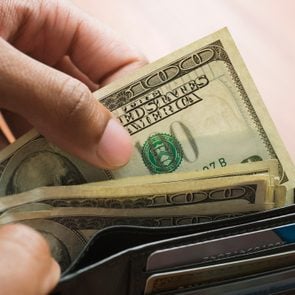This One Habit Prevents Me from Living Paycheck to Paycheck
Updated: Nov. 23, 2023

My bills felt overwhelming until I started saving with a sinking fund. Here's how this financial strategy changed everything for me—and can do the same for you.
I used to absolutely dread certain months of the year. All the winter months topped my list, though February was the worst, and August turned me into a giant ball of stress. The reason? Bills. If you live in the northeast, like I do, then you know how painful those heating-oil bills can be. And when February rolled around, Christmas had just passed, and I was hit with insurance premiums on top of oil bills—on top of all my other regular expenses. During those months, I lived paycheck to paycheck and had no idea how to turn it around or cut back even more than I already had. After all, there are only so many ways to negotiate and save money, and only so many things to stop buying.
But a few years ago, my husband and I stumbled upon financial expert Dave Ramsey and a savings strategy he recommends called the sinking fund. Long story short: We decided to hunker down for 22 months and follow Ramsey’s plan to get out of debt and get rid of our financial stress by making some lifestyle changes. Using a sinking fund was one of those changes—and it’s the reason I no longer live paycheck to paycheck, no matter what time of year it is.
This saving method has kept us stress-free for more than two years now, and I can’t imagine my life without it. However, it’s worth pointing out that creating and maintaining a sinking fund probably isn’t something you can do in just a few minutes. It takes time and planning, and if you’re not sure how to make a budget, you’ll need to look into that first. But if you’re ready to give it a try, here’s everything you need to know about how to start a sinking fund.
Get Reader’s Digest’s Read Up newsletter for more money tips, humor, cleaning, travel, tech and fun facts all week long.
What is a sinking fund?
A sinking fund is a way to save up for big expenses over time. Whether you’re saving up for large bills you know are coming, a new car, a vacation or a kitchen renovation, you’ll put a little bit of money away each month toward your goal. This money is kept separate from your checking and savings accounts, and it’s earmarked for something specific.
According to personal finance expert George Kamel, co-host of The Ramsey Show, the sinking fund is for people in all stages of life and can be used to save up for just about anything. With a sinking fund in place, he says, “you’re ready before something big happens.”
The amount of money you put away each month depends on how much you need to save and how long you have to save it. For example, let’s say you want to save $2,000 for Christmas. If you start saving in January, you’ll have to put $167 into your sinking fund each month in order to have $2,000 by December. If you start saving in June, you’ll have to up that number to $333 per month to reach your goal. My husband and I fine-tune our sinking fund every January. We then work that amount into our monthly budget and set the funds to transfer automatically from our checking account every pay period. That way, we pay ourselves first. (On the flip side, there are a few bills you shouldn’t put on autopay.)
Why is it called a sinking fund?
Kamel says there’s not much information on the exact origins of the sinking fund—or how it got its name. “The term ‘sinking fund’ seems to have started from the business world, where a company would set aside revenue over a period of time to fund a future expense or to fund repayment of a long-term debt,” he explains. “Dave [Ramsey] didn’t come up with the term, but he does recommend using a sinking fund within your budget.”
Even personal finance experts rely on this saving method. Kamel says that sinking funds are something that he and his wife use regularly in their budget to save up for various expenses. If you’re looking for more ways to save money, here are some great money-saving challenges you can start now.
The benefits of a sinking fund
There are loads of benefits to having a sinking fund. For starters, it puts you on the path to being able to afford the thing you want. Then, once you’ve saved enough to cover your purchase, you simply pull out the allotted funds and pay in full. Which brings me to another perk: Paying in cash is one of our favorite ways to save money, since many small businesses will give you a discount if you pay in full and pay in cash. Plus, when you put a large purchase on a credit card and pay it off over time, you end up paying more in the long run because of interest.
A sinking fund also keeps you on track with your financial goals because nothing is a giant surprise. “Using a sinking fund is looking toward the future and being strategic so that you’re prepared,” Kamel explains. He also points out that it helps you develop good savings habits, “so when a bigger expense pops up, like a house down payment, “you’ve already built the habit of putting money away.”
Additionally, a sinking fund allows you to budget for fun! It’s not all about bills. Our sinking fund also includes saving for vacations and annual passes to our local aquarium and amusement park.

How is a sinking fund different than a savings account?
A sinking fund is money you set aside for something specific. Whether you have one sinking fund for all your planned expenses or a sinking fund for each individual expense, the money in that fund is money you have intentionally set aside for that specific thing. It’s meant to be spent. A savings account, on the other hand, is where you keep college savings or extra money for a rainy day.
Lumping your sinking funds and savings into one account can become confusing unless your bank allows you to set up different funds or buckets within your main savings account. Otherwise, you may be more likely to spend that earmarked money on something else—especially if your account is linked to a debit card.
It’s worth noting that a sinking fund is also different from an emergency fund. “A sinking fund is for the known. The emergency fund is for the unknown,” Kamel explains. “An emergency is urgent, unexpected and necessary, like a job loss, major car accident or storm damage to your home.” Since a sinking fund is meant to be spent, you’ll definitely want to keep it separate from your emergency fund too.
How to start a sinking fund
Starting a sinking fund takes time and a bit of research, but anyone can create one—even if you feel like you don’t have any extra money to set aside for it. Kamel points out that a sinking fund is simply a line item in your budget. Don’t have an exact budget yet? That’s where you need to start, and the best budget apps can help. If you already have one, you’re ahead of the game, but now you’ll need to reevaluate it.
1. Take an honest look at your budget
Every December, my husband and I plan what might just be the most unromantic date night ever. It’s a night devoted entirely to the next year’s budget and our sinking fund. We decide things like where we want to vacation, whether or not we should increase our Christmas spending and if we want to do any home projects. While it isn’t super exciting, we end the night knowing that we’re on the same page and working toward the same goals.
2. Decide what you want to save for
This is entirely up to you, of course. We budget and save for our biggest expenses, which happen to be heating oil, insurance premiums, Christmas shopping and vacations. We also include any other big-ticket purchases for the upcoming year. Then, once January rolls around, a portion of each paycheck goes into our sinking fund to cover the expenses we’re saving for. We do exactly what Ramsey and his team recommend: We determine how much we need to save, how much time we have to save those amounts and then divide by the number of months.
3. Set up your savings system
We don’t have a separate account for each anticipated expense, but we do have an account that we use as our designated sinking fund and keep separate from our checking and savings accounts. Since we plan so far in advance, we have the money moved automatically each pay period so we don’t have to think about it.
My husband keeps a spreadsheet, so he knows exactly how much of the money in our sinking-fund account is for oil, insurance premiums, next Christmas and whatever else we’re saving for. If spreadsheets aren’t your jam (they’re certainly not mine), there are some banks, like Ally Bank, that allow you to create separate “buckets” within one account. This can make it even easier to keep track of how much money you’ve set aside for each item.
Sinking-fund tips to help you stay on track
- Create a budget before creating a sinking fund. You might also want to check out this list of things money experts tend to buy cheap.
- If you don’t already organize and save bills and receipts, now is the time to start. I have a small filing cabinet where I keep a year or two of old bills and receipts for things like oil deliveries and car maintenance. Looking back at what we typically spend in a year helps us plan for the year ahead.
- Have your sinking-fund money automatically moved each month. Not only is it convenient, but it will also prevent you from spending that money on something you didn’t plan for before you have the chance to move it.
- Plan as far ahead as possible. The farther ahead you plan, the less money you have to put away each month.
- Don’t touch your sinking fund! This may be the hardest one, but hands off until it’s time to use that money for whatever you’ve designated it for.
Moving forward with your saving strategy
I can’t say enough good things about using a sinking fund—it has been total game changer for us. And while it may feel like a somewhat rigid system of savings, it actually gives you the flexibility to do what you really want and actually be able to afford it.
Just remember that things can change, and that’s OK too. Last year, for example, we decided to book a cruise for this December. We priced it out, booked it and began saving. However, a few months later, the cruise line implemented some new requirements that caused us to rethink our plans and ultimately cancel our trip. We had to sit down and decide what we wanted to do because we no longer needed to put quite so much money away every month. Instead, we decided on a handful of smaller trips. We looked at how much we had already saved for vacations, priced out a few other things we’d like to do and adjusted our monthly contribution accordingly. The rest of the money just went into our savings account. In the end, it was a win on a variety of levels.
Now that you know how to create a sinking fund, see where you can save so you can add more to it. Our suggestions? Learn how to save money on groceries, score free stuff and meal plan every week to save thousands each year.
Source:
- George Kamel, personal finance expert and co-host of The Ramsey Show



